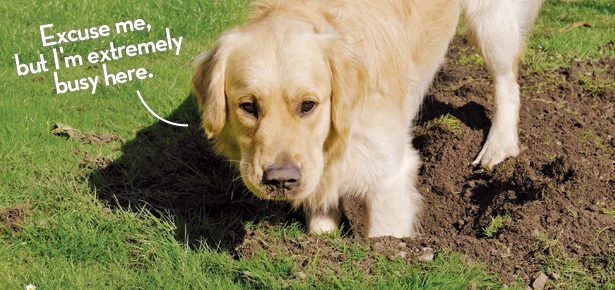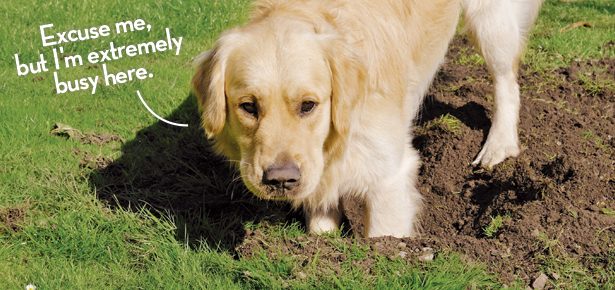

How to Stop Your Dog From Digging
Dogs dig digging. Their people? Not so much. Here’s what to do if you don’t want your dog to dig.
If I had a dollar for every time a training client said they wanted their dog to stop digging, well, you know the rest. Suffice to say it involves yours truly, white sandy beaches and tropical drinks. This is clearly a problem that plagues many a dog lover.
Really, it’s not so much that we want our dogs to stop digging; we just want them to stop digging in inconvenient places, like that lovely bed of roses we worked so hard to grow.
To understand how to fix the problem, it’s important to understand the reasons it might happen in the first place. Some dogs, especially those who are relegated to the back yard for many hours each day, are simply bored. Digging is a way to expend energy. In those cases, more exercise, mental stimulation through training and puzzle toys, and leaving the dog with something like a stuffed Kong to work on can help. But if the excavations are focused around the perimeter of the yard, the digging may be an escape attempt. Strengthening the fencing, along with blocking the overly stimulating view to the outside, might be in order.
Here’s the tough part: digging is an instinctive canine behaviour, and innate behaviours can be difficult to extinguish. Sure, you could use a punishment-based method where something surprises, sprays, or shocks the dog each time he approaches his favourite digging area, but do you really want to do that to your dog? Besides, punishment has fallout. I’ve seen more than a few dogs who have received shocks for approaching flower beds and are then afraid to be in the backyard at all. Other forms of punishment may be milder, but what are you going to do—set up booby traps all around the yard? Punishment isn’t advisable nor is it feasible.
Instead, let’s take a cooperative approach that allows dogs to exercise their natural instincts, but in a way that’s acceptable to us. It involves creating a Dig Pit. Even the most fastidious owner normally has some small space in the yard, typically a far corner, that they wouldn’t mind donating to the cause. Find a spot that is acceptable to you that has some beautiful, dig-able dirt. Now, you can’t very well drag your dog over to it and explain that these are the new digs for digging; you’ve got to give him some motivation to focus his excavations there. Not only that, but you’ve got to be sneaky about it. While your dog is indoors, take a marrow bone, bully stick, or whatever type of yummy treat he loves and bury it in that spot. Bury a few cookies in the pit as well for good measure, making sure to spread them around. Re-cover it all so the goodies are buried somewhat deeply. The dirt you’ve loosened will be a siren song to your dog. Chances are he’ll head right for the area, and when he digs there he’ll be rewarded with all sorts of delightful treats. Repetition will strengthen the association between digging in that spot and tasty rewards, which will increase the chances that he’ll want to dig there again.
The only reasons I’ve ever come across for a dig pit not to work is when there is something else in the yard, such as underground critters, and those critters are of higher value to the dog than any treats that could possibly be offered. In those cases, ridding the yard of the critters will help. But for most dogs, taking a “don’t fight ‘em, join ‘em” approach by setting up and then routinely refilling the dig pit with fresh dirt and periodic buried “treasure” is much easier—and ultimately successful—than punishing the behaviour, and much more pleasant for everyone involved. Can ya dig it?
Nicole Wilde is an award-winning author of ten books on canine behaviour. Her books, seminar DVDs, and Wilde About Dog blog can be found at nicolewilde.com.
Join the newsletter and never miss out on dog content again!
"*" indicates required fields
By clicking the arrow, you agree to our web Terms of Use and Privacy & Cookie Policy. Easy unsubscribe links are provided in every email.





